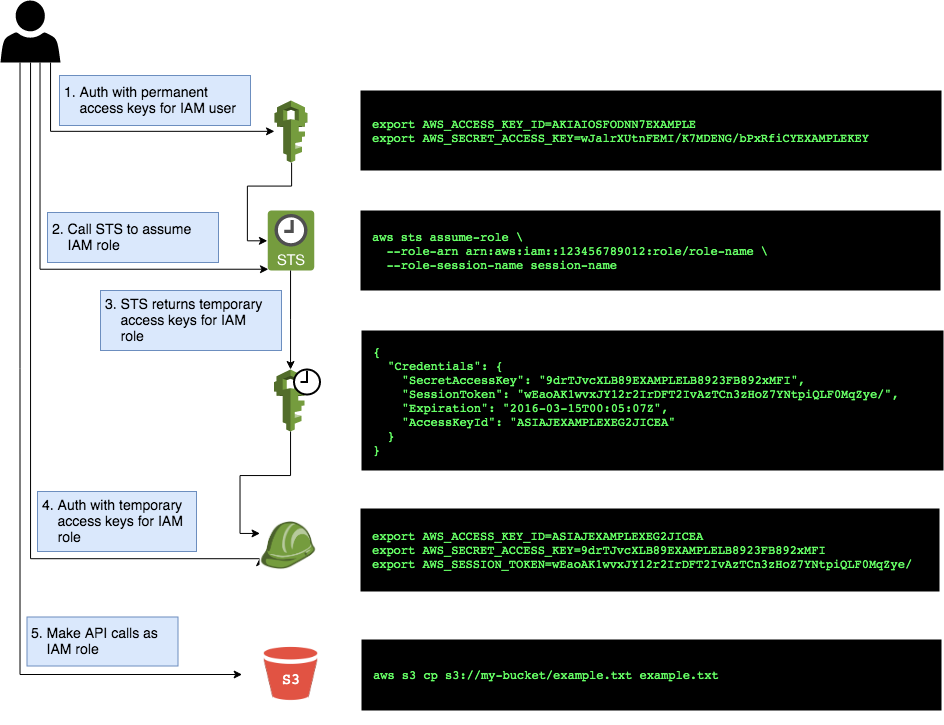IAM roles
An IAM role is a standalone IAM entity that (a) allows you to attach IAM policies to it, (b) specify which other IAM entities to trust, and then (c) those other IAM entities can assume the IAM role to be temporarily get access to the permissions in those IAM policies. The two most common use cases for IAM roles are:
Service roles
Whereas an IAM user allows a human being to access AWS resources, one of the most common use cases for an IAM role is to allow a service—e.g., one of your applications, a CI server, or an AWS service—to access specific resources in your AWS account. For example, you could create an IAM role that gives access to a specific S3 bucket and allow that role to be assumed by one of your EC2 instances. The code running on that EC2 instance will then be able to access that S3 bucket without you having to manually copy AWS credentials (i.e., access keys) onto that instance.
Cross account access
Another common use case for IAM roles is to grant an IAM entity in one AWS account access to specific resources in
another AWS account. For example, if you have an IAM user in account A, then by default, that IAM user cannot
access anything in account B. However, you could create an IAM role in account B that gives access to a specific
S3 bucket in account B and allow that role to be assumed by an IAM user in account A. That IAM user will then be
able to access the contents of the S3 bucket by assuming the IAM role in account B. This ability to assume IAM
roles across different AWS accounts is the critical glue that truly makes a multi AWS account structure possible.
Here are some more details on how IAM roles work:
IAM policies
Just as you can attach IAM policies to an IAM user and IAM group, you can attach IAM policies to an IAM role.
Trust policy
You must define a trust policy for each IAM role, which is a JSON document (very similar to an IAM policy) that
specifies who can assume this IAM role. For example, here is a trust policy that allows this IAM role to be assumed
by an IAM user named Bob in AWS account 111122223333:
{
"Version": "2012-10-17",
"Statement": [
{
"Effect": "Allow",
"Action": "sts:AssumeRole",
"Principal": { "AWS": "arn:aws:iam::111122223333:user/Bob" }
}
]
}
Note that a trust policy alone does NOT automatically give Bob the ability to assume this IAM role. Cross-account
access always requires permissions in both accounts. So, if Bob is in AWS account 111122223333 and you want him to
have access to an IAM role called foo in account 444455556666, then you need to configure permissions in both
accounts: first, in account 444455556666, the foo IAM role must have a trust policy that gives sts:AssumeRole
permissions to account 111122223333, as shown above; second, in account 111122223333, you also need to attach an
IAM policy to Bob’s IAM user that allows him to assume the foo IAM role, which might look like this:
{
"Version": "2012-10-17",
"Statement": [
{
"Effect": "Allow",
"Action": "sts:AssumeRole",
"Resource": "arn:aws:iam::444455556666:role/foo"
}
]
}
Assuming an IAM role
IAM roles do not have a user name, password, or permanent access keys. To use an IAM role, you must assume it by
making an AssumeRole API call (see the
AssumeRole API and
assume-role CLI command), which will return
temporary access keys you can use in follow-up API calls to authenticate as the IAM role. The temporary access keys
will be valid for 1-12 hours, depending on IAM role settings, after which you must call AssumeRole again to fetch
new keys. Note that to make the AssumeRole API call, you must first authenticate to AWS using some other
mechanism. For example, for an IAM user to assume an IAM role, the workflow looks like this:
 The process for assuming an IAM role
The process for assuming an IAM role
The basic steps are:
Authenticate using the IAM user’s permanent AWS access keys
Make the
AssumeRoleAPI callAWS sends back temporary access keys
You authenticate using those temporary access keys
Now all of your subsequent API calls will be on behalf of the assumed IAM role, with access to whatever permissions are attached to that role
IAM roles and AWS services
Most AWS services have native support built-in for assuming IAM roles. For example, you can associate an IAM role directly with an EC2 instance, and that instance will automatically assume the IAM role every few hours, making the temporary credentials available in EC2 instance metadata. Just about every AWS CLI and SDK tool knows how to read and periodically update temporary credentials from EC2 instance metadata, so in practice, as soon as you attach an IAM role to an EC2 instance, any code running on that EC2 instance can automatically make API calls on behalf of that IAM role, with whatever permissions are attached to that role. This allows you to give code on your EC2 instances IAM permissions without having to manually figure out how to copy credentials (access keys) onto that instance. The same strategy works with many other AWS services: e.g., you use IAM roles as a secure way to give your Lambda functions, ECS services, Step Functions, and many other AWS services permissions to access specific resources in your AWS account.